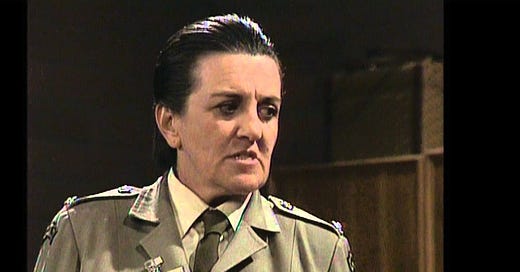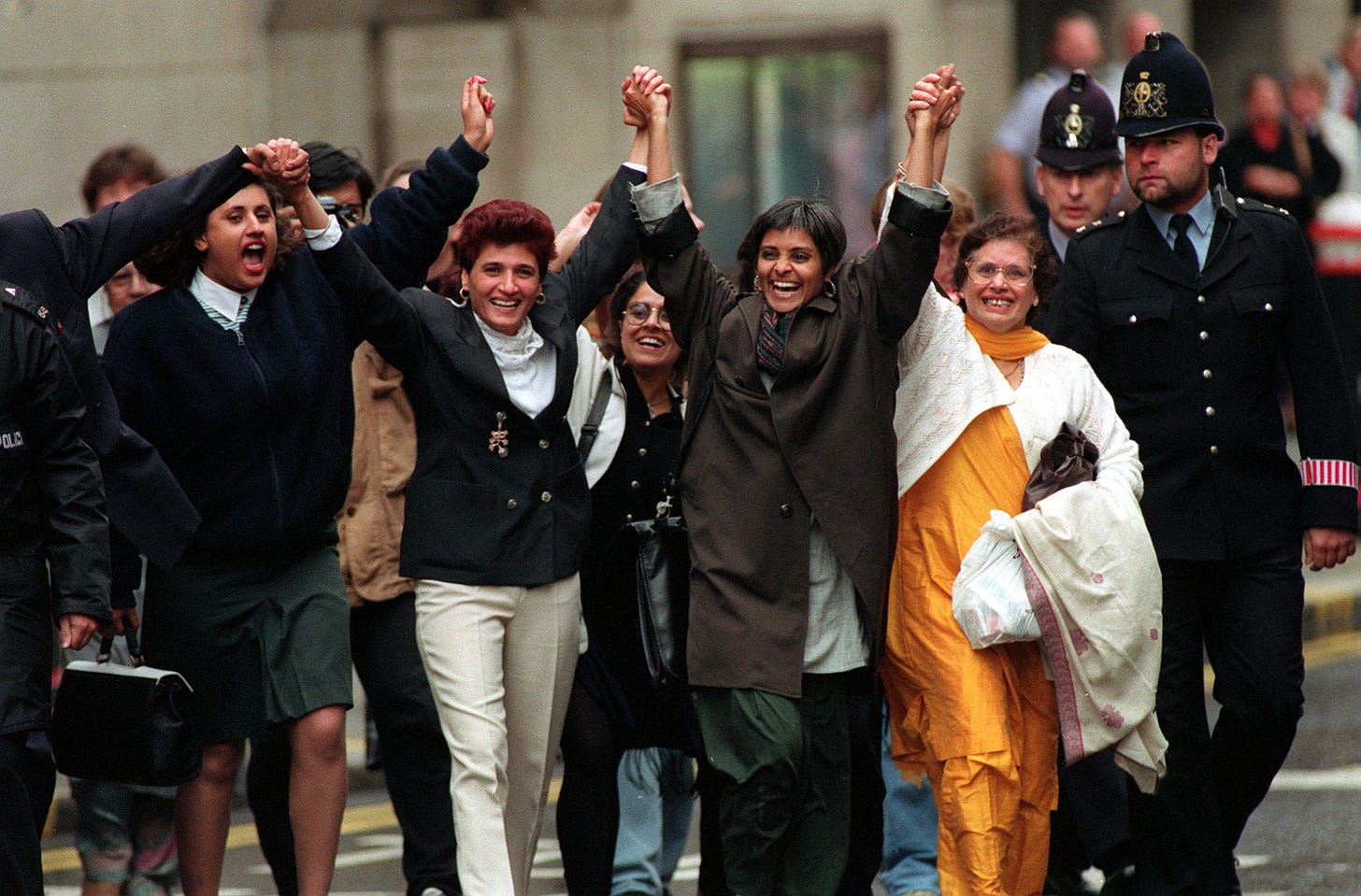Are Lesbians Violent?
What do we know, and what are we told, about violence by and between lesbians?
Joan Ferguson, Prisoner Cell Block H
“I was kidnapped once by a gang of lesbians. They tied me up and forced me to watch Prisoner Cell Block H over and over again. It was almost unbearable.” This tongue in cheek comment was posted on a website aimed at lesbians and gay men monitoring homophobia. It was one of the hundreds of responses to the latest rumour about violent lesbians taking over the world.
I’ve just had what feels like the millionth press release from an anti-feminist pressure group, telling me of its “new research” on the prevalence of domestic violence within lesbian relationships. Apparently, we batter the hell out of each other at a higher rate than men do women in heterosexual relationships. According to this misogynistic, anti-lesbian group, more than half of all of lesbian relationships are violent.
Whatever the prevalence, it certainly is not 50%. But where does the myth of the violent lesbian come from? It’s not just crazy men’s rights activists that pedal this bullshit, but also other, less bonkers people.
Lesbians being threatening and violent is an age-old stereotype that goes right back. In 1954, for example, the psychiatrist Frank S Caprio wrote in his book, Female Homosexuality: “Usually, the aggressive lesbian becomes jealous of her feminine passive partner. One lesbian informed me that she threatened to kill her friend if she threatened to go out with a man.”
Killing Eve
Back in 2007, another tall tale involving violent lesbians was peddled in the form of a story on Fox News Channel programme, “The O'Reilly Factor” which was captioned, “Violent Lesbian Gangs a Growing Problem.” O’Reilly, known to be involved in the Evangelical Christian movement, claimed that, “A national underground network of pistol-packing lesbians is terrorising America. All across the country, they are raping young girls, attacking heterosexual males at random, and forcibly indoctrinating children as young as 10 into the homosexual lifestyle.”
A few years ago I wrote about the case of Wayne Buckle, a DVD bootlegger who was attacked by seven women, described by witnesses in court as a “lesbian gang” in New York City, in 2007. The women claim that Buckle had subjected them to homophobic abuse after one of them resisted his advanced, which Buckle denies. “It was a hate crime against a straight man by a ton of lesbians,” said Buckle from his hospital bed soon after the attack. “This is what the world is coming to.”
News of the phenomenon spread, and before long the myth of the marauding lesbian gang, carrying nine-millimetre Glocks painted pink, was born. Rod Wheeler, a Fox News crime analyst said, whilst referring to the fictional gang members, that “They actually carry - some of these groups carry pink pistols.” A recording on You Tube - since proved to be a fake and removed - apparently showed a group of lesbians viciously kicking a man on the ground. The programme alleged that there is a “national underground network” of at least 150 such gangs in the Washington DC area. Wheeler painted a graphic picture of lesbian gangs running amok. "In Tennessee, authorities say a lesbian gang called GTO, Gays Taking Over, are involved in raping young girls," he reported.
The gangs, the rumour goes, call themselves DTO, (Dykes Taking Over) are supposed to be infiltrating schools and lying in wait for young girls in the toilets.
“Imagine your daughter being so afraid of doing something as simple as using the bathroom for fear of getting raped,” said one mother who was interviewed for the item.
No evidence was ever uncovered, before or following the report, that any such gangs exist.
What is it about lesbians that instil fear in people? Why are we often viewed as either lipsticked sex-kittens, there to titillate men, or terrifying bull-dykes, leering at helpless females in prison shower rooms.
Prisons dramas feature prominently in perpetuating the violent lesbian myth. Even in the film of the life of Kiranjit Ahluwalia, who killed her abusive husband and served time in prison has a violent, bullying butch lesbian as her prison nemesis.
Kiranjit Ahluwalia leaving court, 1992
They are also often seen as sexual predators and sadists. Joan Ferguson, known as the Freak, was a character in Prisoner Cell Block H, the Australian prison drama screened in the 1980s. The Freak would put on a pair of leather gloves as a precursor to sexually assaulting terrified prisoners whom she decided needed to be punished. In Bad Girls, the UK prison drama, Shaz Wylie and Denny Blood, who become lovers, are both inside for violent offences. Many of the other inmates are frightened of them, and for good reason. Wylie murdered three people by spiking the oysters she sold in a supermarket, and Blood burned down her children’s home.
Men can get terribly excited by lesbians in a variety of ways. We feature a lot in pornography, both taking part in girl-on-girl action, but also, with monotonous regularity, fighting each other in boxing rings, mud baths, and in military uniform. Why is aggression between lesbians such a popular male fantasy?
Even within the wider gay community, lesbians are often perceived as violent. The owner of a gay bar in Sydney, Australia, applied to have his bar exempted from non-discrimination laws, and ban heterosexuals and lesbians. Claiming that heterosexual women ‘ogled’ his gay male customers, he said that he also “feared attacks by lesbians.” The tribunal concluded that “Sometimes…lesbian groups insult and deride and are even physically violent towards the gay male patrons.”
Significance was placed on serial killer Aileen Wuornos’ sexuality in seeking an ‘explanation’ as to why she killed seven men. Dubbed the “lesbian highway hooker” by US tabloids, much discussion around her reasons for killing focussed on her being a ‘man-hater’, a phrase often synonymous with ‘lesbian’. During the trial of serial killer Rosemary West the prosecution described one victim as having endured “violent and aggressive” lesbian sex at the hands of West.
Aileen Wuornos
Just like the rumours about the marauding gang members preying on young girls for sex, this is often reflected in popular culture. The lesbian vampire film – a subgenre of the horror movie – depicts predatory, blood-sucking lesbians targeting vulnerable heterosexual women and ‘infecting’ them with a lust for blood and lesbianism.
Although there are now a variety of depictions of lesbians on TV these days, some script writers still rely on the criminally deviant role model. Crime Scene Investigation (CSI), which trails the investigations of a team of Las Vegas forensic scientists, has on more than one occasion routinely depicted lesbian characters driven to kill due to their sexuality – either because they are desperate to hide their sexual orientation, or as a result of being psychotically jealous of their lovers.
Is there something in us that, as a result of living so much of our lives in fear of homophobic attack that we bask in the notion that we may be frightening? In the 1980s and 90s, some lesbians, keen to shake off the ‘fluffy’ image, formed direct action protest groups such as the ‘Lesbian Avengers’. During their reign, the Avengers abseiled into the House of Lords after the Clause 28 vote, and crashed into a live BBC news programme, in order to protest state-sanctioned homophobia. They were never violet, just in-your-face.
Lesbians have long been seen as unstable, mentally ill, predatory, and just plain mad. There will always be those that believe we are, by default, part of a monstrous regiment.
Are we bothered? More to the point, are we scary? I am pleased to admit that I actually think we are, but in the nicest possible way.









My working theory is that while all men benefit from the (correct) perception that any man can get violent, many hate that perception. When they get the chance to pretend it’s women who are violent they lean right in - See! Women are just as violent too! Except we really aren’t.
So pick on a subgroup of women. And who better than those uppity bitches who don’t want to have sex with men? Wow! There really must be something wrong with them! They don’t want us and they have the nerve to tell us!! What more evidence do you need?
I'm happy for men, I'm particular, to think we're scary. That adds to what I've come to recognise as a superpower, that is becoming invisible as we age. Frankly, I quite enjoy the notion of being thought of as a scary old dyke that they don't see coming. I need the space around me for all the fucks I no longer give ✊✊